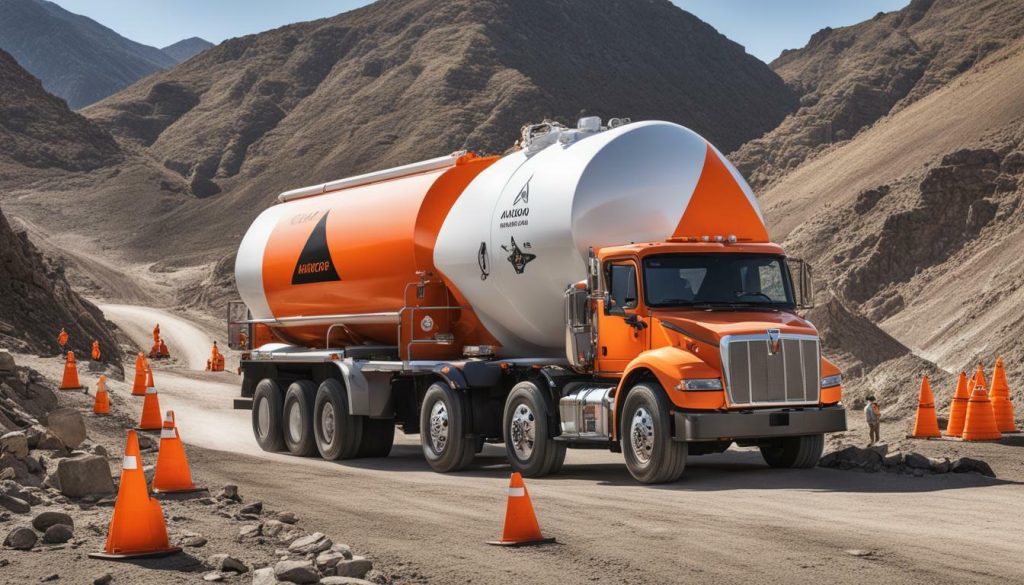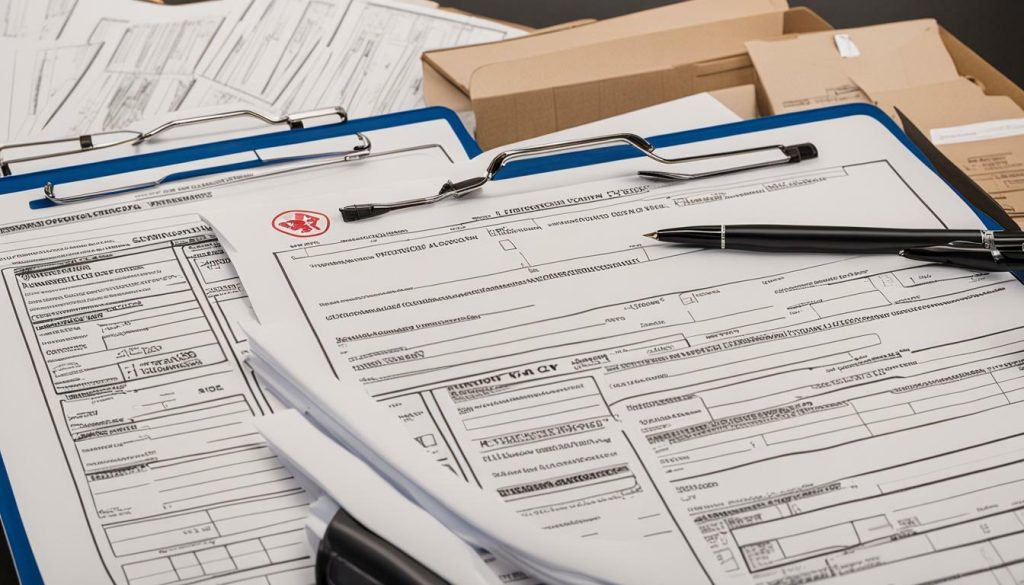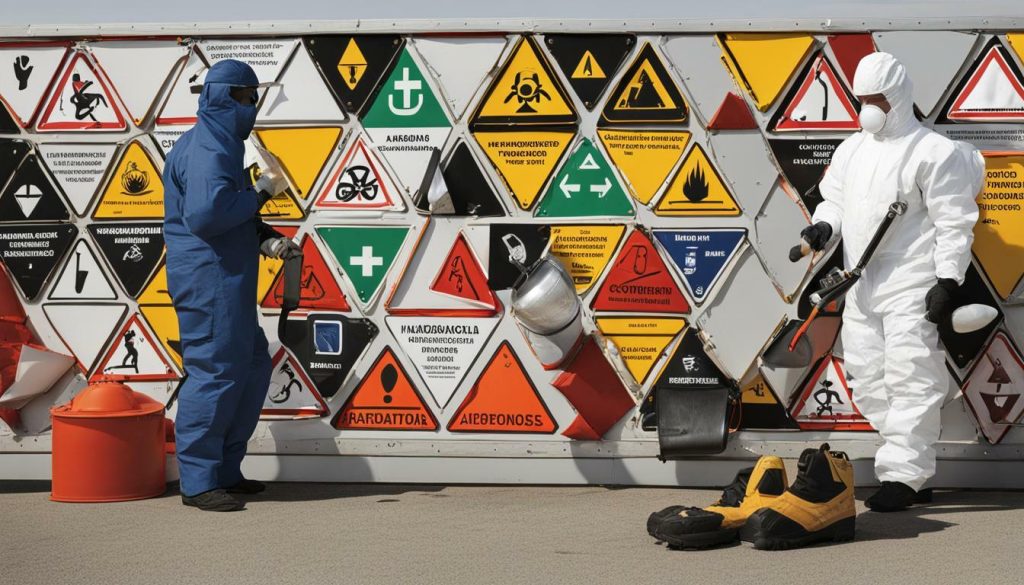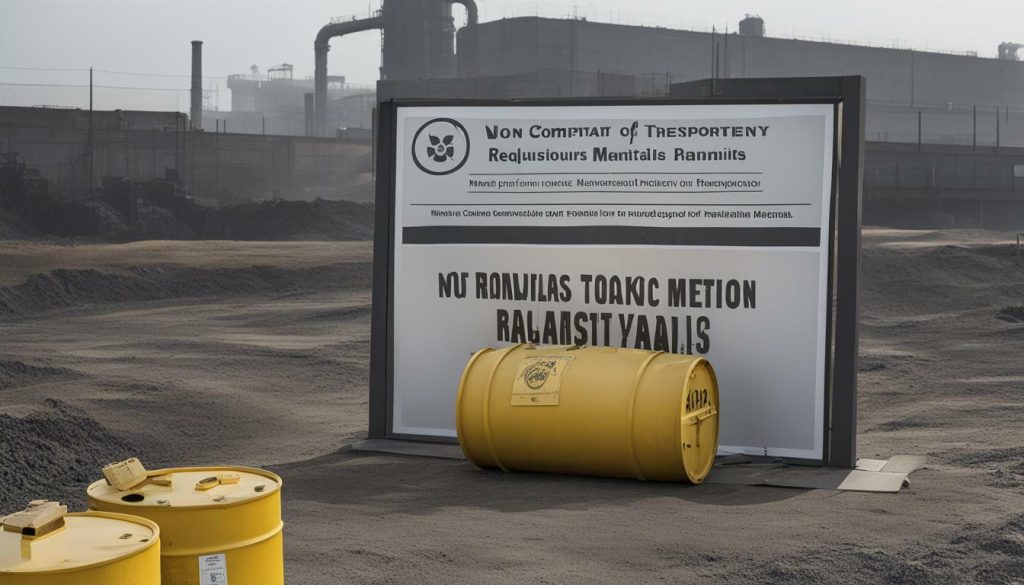Transporting hazardous materials can be a complex and dangerous task that requires strict adherence to federal regulations. Hazardous materials transportation regulations are put in place to protect public safety, the environment, and the health of those involved in the transportation process. Understanding and complying with these regulations is crucial for anyone involved in the transportation of hazardous materials.
Key Takeaways
- Hazardous materials transportation regulations are vital for protecting public safety, the environment, and the health of those involved.
- Compliance with hazardous materials transportation regulations is necessary for safe and legal operations.
- Understanding hazardous materials regulations involves knowledge of regulatory agencies, classification and labeling requirements, packaging and marking specifications, documentation and reporting obligations, and training and certification requirements.
Table of Contents
Understanding Hazardous Materials Regulations
Transporting hazardous materials requires compliance with various regulations enforced by government agencies. The transportation of hazardous materials is a critical concern for public safety and environmental protection. Therefore, it’s essential to understand the regulations to remain compliant and ensure safe transportation.
The rules for transporting hazardous materials are overseen by different government agencies, including the Department of Transportation (DOT), Environmental Protection Agency (EPA), and Pipeline and Hazardous Materials Safety Administration (PHMSA). Regulations specify the requirements for shippers, carriers, and other stakeholders involved in the transportation of hazardous materials. The regulations are updated regularly, necessitating constant monitoring and compliance modification.
Regulations define what hazardous materials are, and how they must be handled and transported. The DOT identifies hazardous materials as any material or substance that poses a risk to health, safety, or property during transportation. Examples of hazardous materials include explosive, flammable, radioactive, poisonous, and corrosive materials.
Failure to comply with the hazardous materials transportation regulations can have severe consequences. Penalties incurred for non-compliance with hazardous materials transportation regulations can result in hefty fines and legal implications, and furthermore, pose a risk to public safety and the environment.

Transportation of Hazardous Materials Rules
The hazardous materials transportation regulations require strict adherence to rules that outline specifics on how to package, label, mark, and document hazardous materials shipments. They define how hazardous materials must be classified and labeled before transport, depending on their physical and chemical properties.
Proper packaging is also critical in the transportation of hazardous materials. The regulations outline the specifications and requirements for containers, closures, and markings. The packaging must be able to withstand the stresses imposed during transport and prevent accidental release or leakage.
Proper documentation and reporting requirements are necessary to ensure the safe transportation of hazardous materials. The regulations require that shipping papers accompany hazardous materials shipments, providing details on the material’s nature and quantity. Emergency response information must also be readily available in case of any incidents during transportation.
Employees involved in the transportation of hazardous materials must receive proper training and certification to ensure they understand the importance of handling hazardous materials safely. The hazardous materials training curriculum is well-documented and designed to educate employees on proper handling, labeling, and transportation of hazardous materials.
- It’s essential to understand the rules and regulations for transportation of hazardous materials to remain compliant and ensure the safety of public and environmental health.
- Regulatory compliance implies strict adherence to rules of packaging, labeling, marking, and documentation, while also understanding the material’s physical and chemical properties.
- Employees must receive proper training and certification to handle hazardous materials safely, which is critical to avoid hefty fines, legal implications, and, most importantly, prevent risks to public safety and the environment.
Classifying and Labeling Hazardous Materials
Proper classification and labeling are crucial when it comes to transporting hazardous materials. The hazardous materials transport process can be dangerous if not handled correctly, which is why it’s essential to identify and label hazardous materials correctly to prevent incidents.
Before transporting hazardous materials, it’s important to understand how to classify them. Hazardous materials are classified based on their properties, and there are nine classes of hazardous materials. These classes are:
- Explosives
- Gases
- Flammable liquids
- Flammable solids
- Oxidizing substances
- Toxic and infectious substances
- Radioactive materials
- Corrosive substances
- Miscellaneous dangerous goods
It’s important to note that some materials may fall into more than one class, and it’s crucial to identify all of their hazardous properties to determine their correct classification.
After determining the correct classification, hazardous materials must be labeled appropriately. The label must have specific elements, including the proper shipping name, identification number, hazard class, and subsidiary hazards. Labeling is essential to inform everyone involved in the transportation process about the potential hazards of the material and how to handle it safely.
In summary, the correct classification and labeling of hazardous materials are critical to ensure the safe and compliant transport of these materials.

Packaging and Marking Requirements
Proper packaging and marking are crucial elements of hazmat transportation regulations. Hazmat shipments must be packaged according to specific requirements to prevent leaks, spills, and other incidents that could endanger public safety. Shippers must use UN-approved packaging and ensure that the containers are compatible with the hazardous materials being shipped.
There are specific container specifications, such as size and weight limits, that must be followed when shipping hazardous materials. In addition, proper closure methods must be used to prevent leaks and spills during transportation. For example, containers must be securely closed, and closures must be protected with a locking mechanism to prevent accidental opening.
Visible markings are required on the outside of each container to indicate the presence of hazardous materials and provide other important information, such as the identification number, proper shipping name, and hazard class. Markings must be legible and in English, and they should be placed on a contrasting background to ensure visibility.

The Department of Transportation (DOT) has established a hazard communication standard that requires shippers to label hazardous materials shipments properly. The labels must be designed to communicate specific information, such as the primary hazard class, subsidiary hazard class, and the type of packaging used. The labels must be prominently displayed on the package and meet specific size and color requirements.
Packaging Exceptions
Some hazardous materials, such as lithium batteries and dry ice, have specific packaging exceptions that allow for alternative packaging methods. Shippers must be knowledgeable about these exceptions and follow the appropriate regulations.
Package Testing and Certification
All hazmat packaging must be tested and certified to ensure it meets the required standards. Shippers must ensure that packaging has been certified for the specific hazardous materials they are shipping. Certificates must be kept on file for a minimum of one year after the date of shipment.
Understanding the hazmat transportation regulations related to packaging and marking is essential for complying with the law and ensuring the safe and efficient transportation of hazardous materials.
Documentation and Reporting Obligations
Documentation and reporting are crucial aspects of complying with hazardous materials transportation regulations. It is essential to provide accurate and complete information about the hazardous materials being transported to ensure the safety of all involved.
The primary document required for hazardous materials transportation is the shipping paper. This document provides information about the contents of the shipment, including the proper shipping name, hazard class, and identification number. The shipping paper must be in a specific format, including specific information and sequence.
In addition to the shipping paper, emergency response information must also be included with the shipment. This information provides guidance on how to respond in case of an emergency involving the hazardous material. The required emergency response information can vary depending on the mode of transportation, but certain information must be provided, such as contact information for the shipper and the consignee, hazards of the material, and emergency response procedures.
If an incident occurs during transportation, such as a spill or leak, it is important to report it promptly to the appropriate authorities. The Department of Transportation (DOT) requires the immediate notification of any hazardous material incidents that result in death, injury, or significant property damage. Reporting requirements can vary depending on the incident and the mode of transportation, but it is crucial to report any incidents promptly and accurately.

Remember, incomplete or inaccurate documentation can result in significant fines and legal repercussions. To avoid such pitfalls, it is essential to stay up to date on the regulatory requirements and ensure that all documentation is complete and accurate.
Training and Certification Requirements
Employees involved in the transportation of hazardous materials must undergo proper training and certification to ensure they are aware of the potential risks and can safely handle and transport the materials. The Department of Transportation requires employers to provide employees with specific training on hazardous materials handling and transportation.
This training should cover a variety of topics, including the classification and identification of hazardous materials, packaging, labeling, placarding, and emergency response procedures. It is essential to ensure that all employees involved in the transportation of hazardous materials understand the risks of non-compliance and the importance of adhering to hazardous materials transportation regulations.
Training must be updated every 3 years, and it is the employer’s responsibility to keep records of employee training and certification. Any new employees must undergo training within 90 days of employment, and any employee whose job duties change must receive additional training to reflect their new role.
It is important to note that different modes of transportation have their specific training requirements, such as air, water, and ground transportation. Employees must receive training specific to the mode of transportation they will be using.
Proper training and certification not only ensure hazardous materials are transported safely, but it also helps to prevent accidents and avoid costly penalties for non-compliance. By investing in training and certification for your employees, you are prioritizing safety and compliance, which ultimately benefits your business.

Enforcement and Penalties for Non-Compliance
Compliance with hazardous materials transportation regulations is critical to ensure the safety of individuals, the environment, and property. Failure to comply with these regulations can have severe consequences, including penalties and fines.
If you violate hazardous materials compliance regulations, you may face penalties which can range from $250 to $100,000 per violation. These penalties can accrue rapidly, especially if multiple violations occur. For repeated or willful violations, penalties can reach up to $500,000 per violation.
Additionally, non-compliance can lead to legal implications, including revocation of the carrier’s or shipper’s operating authority, liability for damages, and potential criminal charges. It is, therefore, imperative that all stakeholders in the hazardous materials transportation process understand and comply with the regulations set forth by the appropriate governing bodies.
To avoid penalties and ensure compliance with hazardous materials regulations, shippers, carriers, and other stakeholders must stay current with any changes to these regulations and maintain proper documentation. Proper training and education are also critical to ensuring compliance and avoiding violations.

By instituting proper compliance measures and emphasizing the importance of safety, you can protect yourself and others from the risks posed by hazardous materials transportation. To maintain compliance, it is essential to stay up-to-date with the rules and regulations governing hazardous materials transportation and to prioritize safety above all else.
Conclusion
Understanding and complying with hazardous materials transportation regulations can be a complex and challenging process. However, it is crucial for ensuring the safety of your employees, the public, and the environment. By familiarizing yourself with the regulations governing the transportation of hazardous materials, you can help prevent accidents and avoid the severe penalties associated with non-compliance.
Remember to classify and label your hazardous materials correctly, follow proper packaging and marking requirements, and document and report all necessary information accurately. Additionally, make sure your employees receive the required training and certification to ensure they understand the risks and obligations associated with hazardous materials transportation.
Stay Compliant with Hazardous Materials Transportation Regulations
By taking a proactive approach and prioritizing safety and compliance, you can establish a culture of responsibility and awareness within your organization. Always stay informed about any updates or changes to hazardous materials transportation regulations and seek assistance when needed. With proper planning and execution, you can maintain a safe, efficient, and legally compliant hazardous materials transportation operation.
FAQ Hazardous Materials Transportation Regulations
Q: What are hazardous materials transportation regulations?
A: Hazardous materials transportation regulations refer to the rules and guidelines set by governmental agencies to regulate the safe and proper transportation of hazardous materials, ensuring the protection of public health and the environment.
Q: Who is responsible for complying with hazardous materials transportation regulations?
A: Various stakeholders are responsible for complying with hazardous materials transportation regulations, including shippers, carriers, freight forwarders, and individuals involved in the packaging, handling, and transport of hazardous materials.
Q: How do I classify hazardous materials?
A: Hazardous materials are classified based on their properties, such as flammability, toxicity, corrosiveness, and reactivity. The classification process helps determine the appropriate packaging, labeling, and handling requirements for safe transportation.
Q: What are the packaging and marking requirements for hazardous materials shipments?
A: Packaging and marking requirements for hazardous materials shipments include using approved containers, ensuring proper closure methods, and prominently displaying visible markings to indicate the presence of hazardous materials.
Q: What kind of documentation is required for hazardous materials transportation?
A: Documentation for hazardous materials transportation includes shipping papers, emergency response information, and incident reporting forms. These documents provide important information about the nature of the hazardous materials being transported and the appropriate response in case of an incident.
Q: Are there any training and certification requirements for employees involved in hazardous materials transportation?
A: Yes, employees involved in hazardous materials transportation must receive proper training and certification to ensure they have the knowledge and skills necessary to handle and transport hazardous materials safely and in compliance with regulations.
Q: What are the penalties for non-compliance with hazardous materials transportation regulations?
A: Non-compliance with hazardous materials transportation regulations can result in penalties, fines, and legal consequences. The severity of the penalties may vary depending on the nature and extent of the violation.


